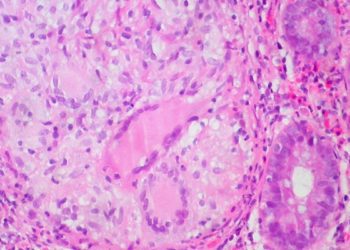Quality improvement methods increase adherence to pediatric UTI guidelines
Image: PD
1. Quality improvement (QI) methods were associated with increased adherence to American Academy of Pediatrics (AAP) guidelines for imaging in children 2-24 months of age with first urinary tract infection (UTI).
2. Though improvements were noted in both inpatient and emergency department (ED) settings, quicker and larger changes were noted in the inpatient setting.
Evidence Rating Level: 1 (Excellent)
Study Rundown: In 2011, the AAP published new guidelines for imaging after a first UTI in children 2-24 months of age. UTIs in children can sometimes be secondary to functional or anatomic abnormalities of the genitourinary tract, with early diagnosis and correction helping to prevent further complications. Renal and bladder ultrasonography (RBUS) and voiding cystourethrogram (VCUG) are two common modalities used to diagnose anomalies. Whereas RBUS is non-invasive, VCUG is a more expensive and invasive procedure involving radiation exposure. The 2011 AAP guidelines suggest RBUS after first UTI in children 2-24 months of age followed by VCUG only if RBUS is abnormal.
This QI study, conducted at a large academic center, aimed to reduce the percentage of guideline-eligible children undergoing VCUG after normal RBUS in both inpatient and ED settings. QI methods included physician and patient education along with updated electronic medical record (EMR) order sets. Additionally, a surveillance system contacted residents of eligible patients with reminders of the guideline. Sustained improvements were noted in both settings, with a higher success rate in the inpatient setting. This study suggests that rapid implementation of national guidelines is possible through QI methods, though this specific intervention is best tailored to academic settings with an EMR.
Click to read the study published today in Pediatrics
Relevant Reading: The New American Academy of Pediatrics Urinary Tract Infection Guideline
Study Author, Dr. Karen E. Jerardi, MD MEd, talks to 2 Minute Medicine: Division of Hospital Medicine, Cincinnati Children’s Hospital Medical Center.
“We were able to rapidly implement the American Academy of Pediatrics guideline for management for first urinary tract infection (UTI) using quality improvement methods. Practice change occurred in both the inpatient and outpatient settings; however, guideline adoption occurred with a greater magnitude in the inpatient setting. Interventions using the electronic medical record and ordering system were most impactful yet were only available for inpatient providers. Recognition of the process of outpatient management of UTI, specifically related to the timing of image ordering and completion, suggests there are opportunities for higher reliability interventions that more effectively fit into the workflow of the outpatient setting.
Imaging completion rates and results were also tracked. While fewer patients underwent voiding cystourethrograms, there were no significant differences in the percentage of patients completing renal ultrasounds or in overall rates of vesicoureteral reflux identification.”
In-Depth [Quality improvement]: Before implementation of this QI project, baseline rates of children undergoing VCUG despite normal RBUS after first UTI were 92% and 100% in the inpatient and ED settings, respectively. In response to new AAP guidelines, this project aimed to reduce the percentage of children with first UTI undergoing VCUG after normal RBUS to 5% in both settings within 120 days. QI methods include physician and patient education on the new guidelines, updated EMR order sets, and a surveillance system that notified residents of eligible patients. Pre- and post-intervention data was obtained through retrospective chart reviews. Inclusion criteria comprised of children aged 2-24 months, with an International Classification of Diseases, Ninth Revision (ICD-9) code of UTI or pyelonephritis. All included patients did not have a history of prior UTI. In one month, improvement from 92% to 0% was noted in inpatient settings. Improvement in the ED occurred from 100% to 40% over 4 months. Importantly, no significant changes in incidence of obtained RBUS or diagnosed anomalies were noted from pre- to post-intervention phases.
By Neha Joshi and Leah H. Carr
More from this author: Inhaled nitric oxide in premature infants shows no benefits, Intrapartum maternal asthma linked to increased disease in children, Racial differences noted in autism care, Short term zinc prophylaxis decreases infant diarrhea mortality, Childhood ADHD significantly associated with adult obesity
© 2013 2minutemedicine.com. All rights reserved. No works may be reproduced without expressed written consent from 2minutemedicine.com. Disclaimer: We present factual information directly from peer reviewed medical journals. No post should be construed as medical advice and is not intended as such by the authors, editors, staff or by 2minutemedicine.com. PLEASE SEE A HEALTHCARE PROVIDER IN YOUR AREA IF YOU SEEK MEDICAL ADVICE OF ANY SORT.






